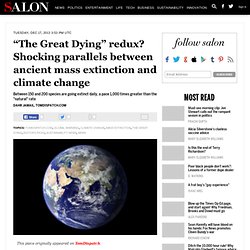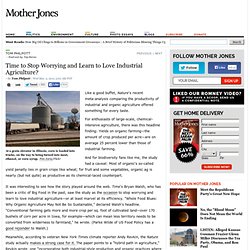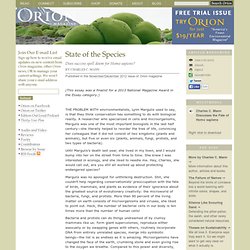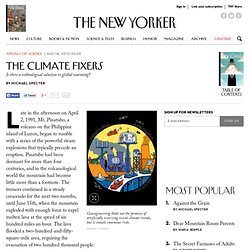

“The Great Dying” redux? Shocking parallels between ancient mass extinction and climate change. I grew up planning for my future, wondering which college I would attend, what to study, and later on, where to work, which articles to write, what my next book might be, how to pay a mortgage, and which mountaineering trip I might like to take next.

Now, I wonder about the future of our planet. During a recent visit with my eight-year-old niece and 10- and 12-year-old nephews, I stopped myself from asking them what they wanted to do when they grew up, or any of the future-oriented questions I used to ask myself. I did so because the reality of their generation may be that questions like where they will work could be replaced by: Where will they get their fresh water? What food will be available? And what parts of their country and the rest of the world will still be habitable? The reason, of course, is climate change — and just how bad it might be came home to me in the summer of 2010. The route had changed dramatically enough to stun me. “We’ve Never Been Here as a Species” Why the City of Miami Is Doomed to Drown. Eight components of a "healing city" As director of NRDC’s sustainable communities work, I spend a lot of time defining (and refining) our goals: what is a sustainable community?

We must know the destination in order to forge a path. But, in this case, that path can be as elusive as Hansel and Gretel’s. In a room of twenty "experts," chances are you'll find a dozen different definitions. I’ve come to believe that there is no fixed definition of a sustainable community, though there are some good descriptions out there, mostly having to do with places that foster environmental, economic and social health in the present without compromising the future.
Forging or choosing a clear statement can be useful, especially for the pragmatic professionals who tend to populate my daily work environment. Time to Stop Worrying and Learn to Love Industrial Agriculture? At a grain elevator in Illinois, corn is loaded into trucks, on the way to being turned into meat, ethanol, or corn syrup.Pete Zaria/Flickr Like a good buffet, Nature's recent meta-analysis comparing the productivity of industrial and organic agriculture offered something for every taste.

For enthusiasts of large-scale, chemical-intensive agriculture, there was this headline finding: Yields on organic farming—the amount of crop produced per acre—are on average 25 percent lower than those of industrial farming. And for biodiversity fans like me, the study had a caveat: Most of organic's so-called yield penalty lies in grain crops like wheat; for fruit and some vegetables, organic ag is nearly (but not quite) as productive as its chemical-laced counterpart. It was interesting to see how the story played around the web. Meanwhile, according to veteran New York Times climate reporter Andy Revkin, the Nature study actually makes a strong case for it. What do I take away from the Nature paper? State of the Species. By Charles C.

Mann (This essay was a finalist for a 2013 National Magazine Award in the Essay category.) THE PROBLEM WITH environmentalists, Lynn Margulis used to say, is that they think conservation has something to do with biological reality. A researcher who specialized in cells and microorganisms, Margulis was one of the most important biologists in the last half century—she literally helped to reorder the tree of life, convincing her colleagues that it did not consist of two kingdoms (plants and animals), but five or even six (plants, animals, fungi, protists, and two types of bacteria). Until Margulis’s death last year, she lived in my town, and I would bump into her on the street from time to time.
Margulis was no apologist for unthinking destruction. Can Geoengineering Solve Global Warming? Late in the afternoon on April 2, 1991, Mt.

Pinatubo, a volcano on the Philippine island of Luzon, began to rumble with a series of the powerful steam explosions that typically precede an eruption. Pinatubo had been dormant for more than four centuries, and in the volcanological world the mountain had become little more than a footnote. The tremors continued in a steady crescendo for the next two months, until June 15th, when the mountain exploded with enough force to expel molten lava at the speed of six hundred miles an hour. The lava flooded a two-hundred-and-fifty-square-mile area, requiring the evacuation of two hundred thousand people.
Within hours, the plume of gas and ash had penetrated the stratosphere, eventually reaching an altitude of twenty-one miles. Bike-Friendly Cities: It Can Happen Here. Back in 2010, former Utne Reader editor Jay Walljasper traveled to Europe to discover the secret behind Holland’s famously bike-friendly cities.

The reputation is well earned: when commuting or running errands, Dutch residents use their bicycles more than a quarter of the time, and in cities like Groningen, the share is more than half. Writing for Solutions (April 2012), Walljasper outlined the Netherlands’ recipe for success: First, start young. In Dutch schools, students are instructed on bicycle and auto safety from a very young age. In Utrecht, kids earn a certificate from the city for passing a bicycle safety test at age 11. Safe options are big. Biking is about convenient alternatives. It’s planning, not DNA. London's Urban Farming Hub Reaches New Heights. The Island Where People Forget to Die.